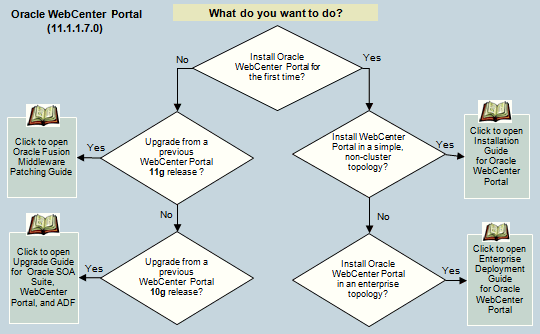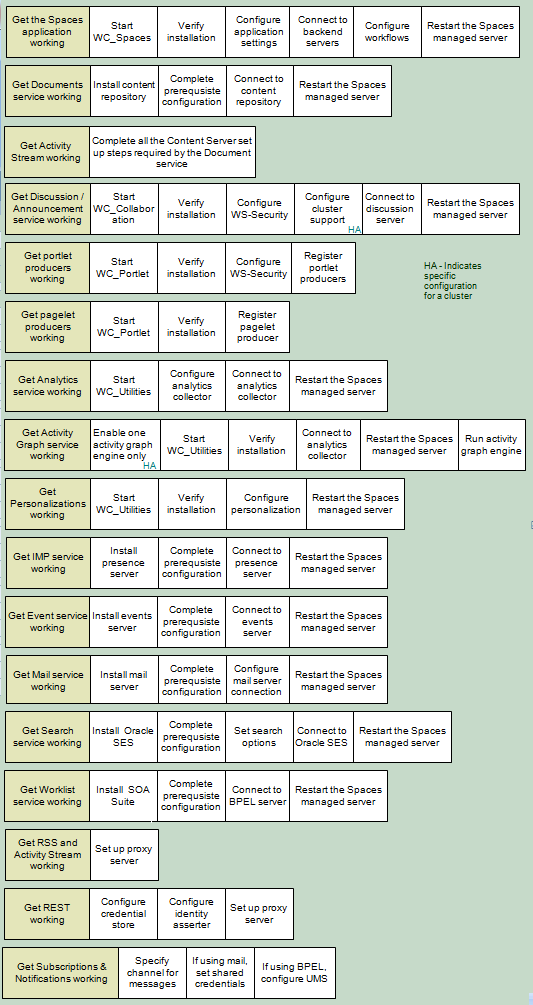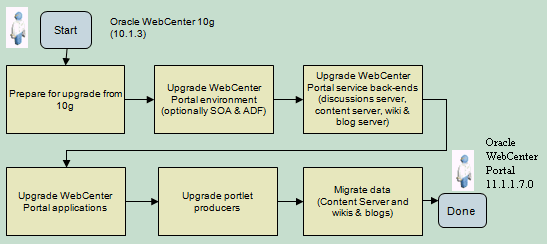Oracle® WebCenter Portal
Installation and Configuration Roadmap
11g Release 1 (11.1.1.7.0) for Windows
E22628-03
April 2013
Welcome to Oracle WebCenter Portal!
Use this documentation roadmap to find instructions on how to install, upgrade, and/or patch Oracle WebCenter Portal, then perform the necessary configurations. In Figure 1, find the starting point that best describes your current environment, then use the links in Table 1 to jump to the Guide that you need.
Figure 1 Starting Points for WebCenter Portal Installation

Description of "Figure 1 Starting Points for WebCenter Portal Installation"
Table 1 Starting Points for WebCenter Portal Installation
| Starting Point | Install Summary | Detailed Instructions |
|---|---|---|
|
New WebCenter Portal Installation |
||
|
Oracle Fusion Middleware Installation Guide for Oracle WebCenter Portal |
|
|
Oracle Fusion Middleware Enterprise Deployment Guide for Oracle WebCenter Portal |
|
|
Existing WebCenter Portal Installation |
||
|
||
|
Oracle Fusion Middleware Upgrade Guide for Oracle SOA Suite, WebCenter Portal, and ADF |
Before you start, review the installation roadmap for your installation:
Installing WebCenter Portal for the First Time
Upgrading an Existing WebCenter Portal 11g Installation
Upgrading an Existing WebCenter Portal 10g Installation
Note:
For existing installations, note that upgrades may include new features that will need to be configured as described in the section on New Oracle WebCenter Portal Installations - Roadmaps.
1 New Oracle WebCenter Portal Installations - Roadmaps
The roadmaps in this section provide an overview of the steps required to install Oracle WebCenter Portal and guides you to the documentation. Oracle provides documentation for two installation scenarios:
-
Simple topology - install Oracle WebCenter Portal in a simple, non-clustered environment. Figure 2 illustrates the installation process for a simple topology. Use Table 2 to navigate to the appropriate Guide.
-
Enterprise topology - install Oracle WebCenter Portal in a distributed environment with built-in security and high availability. Figure 3 illustrates the installation process for an enterprise topology. Use Table 3 to navigate to the appropriate Guide.
Figure 4 shows post-installation steps required to configure WebCenter Portal components and services that are required for both topologies. Use Table 4 to navigate to the appropriate Guide.
Before you start, you might like to read:
Figure 2 Installing Oracle WebCenter Portal for the First Time - Simple Topology

Description of "Figure 2 Installing Oracle WebCenter Portal for the First Time - Simple Topology"
Use Table 2 to navigate to the appropriate Guide.
Table 2 Installing Oracle WebCenter Portal for the First Time - Simple Topology
| Task and link to more information | Mandatory or Optional? | Notes |
|---|---|---|
|
Mandatory |
||
|
Verify system requirements, then install and configure a database |
Mandatory |
|
|
Mandatory |
If you want to use Spaces as well as build WebCenter Portal applications you must run the RCU twice as both require their own WEBCENTER schema. Schemas for the Discussions service and portlets are also required if you plan to use those services. If you plan on using the Recommendation service, then the Activity Graph product needs to be installed. Analytics and Activity Graph can be used only by a single application within a domain. If Activity Graph is installed, the |
|
|
Mandatory |
||
|
Install Oracle WebCenter Portal: |
Mandatory |
|
|
Install other Fusion Middleware products: |
Optional |
SOA is mandatory for the Worklist service and Spaces workflows. Oracle WebCenter Content is mandatory for Content Presenter, wiki, and the Documents service. Oracle HTTP Server (OHS) is recommended for Oracle WebCenter Content Server integration and for single sign-on (SSO) since SSO is needed to stop multiple login prompts), and is required for REST and SOA. |
|
Mandatory |
You may choose to create a new domain or extend an existing domain for WebCenter Portal. |
|
|
Extend the WebCenter Portal domain to: |
Optional |
Oracle does not recommend deploying WebCenter Portal applications or WebCenter Portal Producer applications to the Administration Server or any of the default managed servers created during Oracle WebCenter Portal installation. |
|
Start the servers: |
Mandatory |
|
|
Mandatory |
Mandatory for Oracle WebCenter Content Server and Discussions |
|
|
Optional |
Mandatory for Content Presenter, wiki and the Documents service. |
|
|
Install, configure, and connect back-end components for WebCenter Portal services: |
Optional |
Mandatory for the WebCenter Portal services you want to use See also, Post-install Configuration for WebCenter Portal Components and Services |
Figure 3 Installing Oracle WebCenter Portal for the First Time - Enterprise Topology

Description of "Figure 3 Installing Oracle WebCenter Portal for the First Time - Enterprise Topology"
Use Table 3 to navigate to the appropriate Guide.
Table 3 Installing Oracle WebCenter Portal for the First Time - Enterprise Topology
| Task and link to more information | Mandatory or Optional? | Notes |
|---|---|---|
|
Mandatory |
||
|
Mandatory |
||
|
Mandatory |
||
|
Mandatory |
||
|
Optional |
||
|
Mandatory |
||
|
Mandatory |
||
|
Mandatory |
||
|
Mandatory |
||
|
Mandatory |
||
|
Mandatory |
||
|
Mandatory |
||
|
Optional |
||
|
Mandatory |
Option to configure the domain for the Spaces application or create a custom managed server for WebCenter Portal applications |
|
|
Mandatory |
||
|
Mandatory |
||
|
Install and configure back-end components for required WebCenter Portal services: |
Optional |
Mandatory for the WebCenter Portal services you want to use See also, Post-install Configuration for WebCenter Portal Components and Services |
|
Optional |
Mandatory for the Spaces application |
|
|
Optional |
Mandatory for the Spaces application |
|
|
Optional |
Mandatory for the Spaces application |
|
|
Optional |
Mandatory for the Spaces application |
|
|
Optional |
Mandatory for the Spaces application |
|
|
Mandatory |
Figure 4 Post-install Configuration for WebCenter Portal Components and Services

Description of "Figure 4 Post-install Configuration for WebCenter Portal Components and Services"
Use Table 4 to navigate to the appropriate Guide.
Table 4 Getting WebCenter Portal Components and Services Working
| WebCenter Portal Component/Service | Feature | Documentation |
|---|---|---|
|
Spaces application |
||
|
Documents service |
Document management, wikis, blogs, content presenter |
|
|
Activity Stream service |
Activity streaming |
Requires Oracle WebCenter Content Server to be set up for the Document service |
|
Discussions and Announcement services |
Discussion forums and announcements |
In a clustered environment, additional configuration is required. More |
|
Portlet producers |
WSRP, PDK-Java portlets |
|
|
Pagelet producers |
Pagelets |
|
|
Analytics service |
Analytics reports |
|
|
Activity Graph service |
Recommendation and similar item task flows |
Connect to analytics collector In a clustered environment, the activity graph engine must be be targeted to a single managed server (not the cluster). More |
|
Personalization service |
Personalization scenarios |
|
|
Instant Messaging and Presence service |
Presence status, other presence options (such as send mail, send instant message, start phone conference) |
|
|
Event service |
Personal calendar and Space event management |
|
|
Mail service |
Mail task flow |
|
|
Search service |
Search task flows |
|
|
Worklist service |
Worklist task flows |
|
|
RSS News Feeds |
External RSS news feeds |
|
|
REST services |
RESTful interface to WebCenter Portal services |
|
|
Subscriptions and Notifications |
Notifications about subscribed services and objects |
2 Existing Oracle WebCenter Portal 11g Installation - Roadmaps
Table 5 lists the Oracle WebCenter Portal installation scenarios that you can patch to the latest release 11.1.1.7.0, and guides you to the documentation in Oracle Fusion Middleware Patching Guide.
Table 5 Applying the Latest Patch to Oracle WebCenter Portal 11g Installations
| Starting Point | Documentation Link in Oracle Fusion Middleware Patching Guide |
|---|---|
|
Oracle WebCenter Portal 11.1.1.6.0 Installation |
See section "Patching an Oracle WebCenter Portal 11.1.1.6.0 Installation" |
|
Oracle WebCenter Portal 11.1.1.4.0 or 11.1.1.5.0 Installation |
See section "Patching an Oracle WebCenter 11.1.1.4.0 or 11.1.1.5.0 Installation" |
|
Oracle WebCenter Portal 11.1.1.2.0 or 11.1.1.3.0 Installation |
See section "Patching an Oracle WebCenter 11.1.1.2.0 or 11.1.1.3.0 Installation" |
|
Oracle WebCenter Portal 11.1.1.1.0 Installation |
See section "Patching an Oracle WebCenter 11.1.1.1.0 Installation" |
Before you start, you may also like to read Oracle Fusion Middleware Installation Planning Guide.
3 Existing Oracle WebCenter Portal 10g Installation - Roadmap
If you are currently running Oracle WebCenter 10g (10.1.3) you must upgrade your Oracle Application Server 10g environment to Oracle Fusion Middleware 11g, and then upgrade your WebCenter Portal applications from 10g (10.1.3) to 11g (11.1.1.7.0). Figure 5 illustrates the steps required. Use Table 6 to navigate to the appropriate Guide.
Before you start, you may also like to read:
Figure 5 Upgrading from Oracle WebCenter 10g 10.1.3

Description of "Figure 5 Upgrading from Oracle WebCenter 10g 10.1.3"
Use Table 6 to navigate to the appropriate Guide.
Table 6 Upgrading from Oracle WebCenter 10g 10.1.3
| Task and link to more information | Mandatory or Optional? | Notes |
|---|---|---|
|
Mandatory |
||
|
Mandatory |
Upgrade ADF. Also upgrade SOA if installed |
|
|
Mandatory |
Only mandatory for services that you use |
|
|
Mandatory |
||
|
Mandatory |
||
|
Migrate data on Oracle Content DB and Oracle Wiki and Blog server |
Mandatory |
4 Documentation Accessibility
For information about Oracle's commitment to accessibility, visit the Oracle Accessibility Program website at http://www.oracle.com/pls/topic/lookup?ctx=acc&id=docacc.
Oracle customers have access to electronic support through My Oracle Support. For information, visit http://www.oracle.com/pls/topic/lookup?ctx=accid=info or visit http://www.oracle.com/pls/topic/lookup?ctx=accid=trs if you are hearing impaired.
Oracle Fusion Middleware Administrator's Guide for Oracle WebCenter Portal, 11g Release 1 (11.1.1.7.0) for Windows
E22628-03
Copyright © 2009, 2013, Oracle and/or its affiliates. All rights reserved.
This software and related documentation are provided under a license agreement containing restrictions on use and disclosure and are protected by intellectual property laws. Except as expressly permitted in your license agreement or allowed by law, you may not use, copy, reproduce, translate, broadcast, modify, license, transmit, distribute, exhibit, perform, publish, or display any part, in any form, or by any means. Reverse engineering, disassembly, or decompilation of this software, unless required by law for interoperability, is prohibited.
The information contained herein is subject to change without notice and is not warranted to be error-free. If you find any errors, please report them to us in writing.
If this is software or related documentation that is delivered to the U.S. Government or anyone licensing it on behalf of the U.S. Government, the following notice is applicable:
U.S. GOVERNMENT RIGHTS Programs, software, databases, and related documentation and technical data delivered to U.S. Government customers are "commercial computer software" or "commercial technical data" pursuant to the applicable Federal Acquisition Regulation and agency-specific supplemental regulations. As such, the use, duplication, disclosure, modification, and adaptation shall be subject to the restrictions and license terms set forth in the applicable Government contract, and, to the extent applicable by the terms of the Government contract, the additional rights set forth in FAR 52.227-19, Commercial Computer Software License (December 2007). Oracle America, Inc., 500 Oracle Parkway, Redwood City, CA 94065.
This software or hardware is developed for general use in a variety of information management applications. It is not developed or intended for use in any inherently dangerous applications, including applications that may create a risk of personal injury. If you use this software or hardware in dangerous applications, then you shall be responsible to take all appropriate fail-safe, backup, redundancy, and other measures to ensure its safe use. Oracle Corporation and its affiliates disclaim any liability for any damages caused by use of this software or hardware in dangerous applications.
Oracle and Java are registered trademarks of Oracle and/or its affiliates. Other names may be trademarks of their respective owners.
Intel and Intel Xeon are trademarks or registered trademarks of Intel Corporation. All SPARC trademarks are used under license and are trademarks or registered trademarks of SPARC International, Inc. AMD, Opteron, the AMD logo, and the AMD Opteron logo are trademarks or registered trademarks of Advanced Micro Devices. UNIX is a registered trademark licensed through X/Open Company, Ltd.
This software or hardware and documentation may provide access to or information on content, products, and services from third parties. Oracle Corporation and its affiliates are not responsible for and expressly disclaim all warranties of any kind with respect to third-party content, products, and services. Oracle Corporation and its affiliates will not be responsible for any loss, costs, or damages incurred due to your access to or use of third-party content, products, or services.